Collection of materials relating to neuro-ophthalmology as part of the Neuro-Ophthalmology Virtual Education Library.
NOVEL: https://novel.utah.edu/
TO
- NOVEL981
Filters: Collection: "ehsl_novel_novel"
| Title | Creator | Description | Subject | ||
|---|---|---|---|---|---|
| 201 |
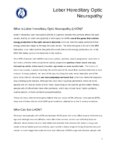 |
Hereditary Optic Neuropathy (Leber's Hereditary Optic Neuropathy) | NANOS | Hereditary Optic Neuropathy - A hereditary optic neuropathy is caused by a genetic variant (or mutation) that causes dysfunction of the neurons (nerve cells) which form the optic nerve. The optic nerve sends information from the back of the eye to the vision center in the brain.The two most common t... | Hereditary Optic Neuropathy; Patient Brochure |
| 202 |
 |
Transient Vision Loss | NANOS | Vision loss that is temporary (transient) is a common problem and has many potential causes.Patients with temporary vision loss often do not have any abnormalities on their eye examination, especially once the vision has returned to normal. | Transient Vision Loss; Patient Brochure |
| 203 |
 |
NExT Introduction | Sachin Kedar, MD, Editor-in-Chief | Transcript of video introduction to the NExT curriculum collection. | NANOS Examination Techniques |
| 204 |
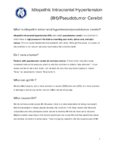 |
Idiopathic Intracranial Hypertension | NANOS | Idiopathic intracranial hypertension (IIH), also called pseudotumor cerebri, is a condition in which there is high pressure in the fluid surrounding your brain, spinal cord, and optic nerves. This can cause headaches and problems with vision. | Idiopathic Intracranial Hypertension; Patient Brochure |
| 205 |
 |
Giant Cell Arteritis | NANOS | Giant cell arteritis is a condition that can cause vision loss, new persistent headaches, scalp tenderness, and jaw pain with chewing. It is due to inflammation of blood vessels primarily of the head and neck. | Giant Cell Arteritis; Patient Brochure |
| 206 |
 |
Thyroid Eye Disease | NANOS | Thyroid eye disease, also called dysthyroid orbitopathy, is an autoimmune condition in whichyour body's immune system triggers inflammation in the eye socket (also called the orbit),affecting the muscles that move the eye and the fatty tissue behind the eye. | Thyroid Eye Disease; Thyroid Orbitopathy; Patient Brochure |
| 207 |
 |
Metastatic Glioblastoma to Intracranial Optic Nerves, Optic Chiasm and Optic Tracts | Bashaer Aldhahwani, MD; Mariam S. Vilá-Delgado, MD | The patient with pathology confirmed glioblastoma after resectioning the superior frontal lobe tumor followed by 6 weeks of radiation therapy with concurrent temozolomide. The patient started bevacizumab to treat steroid-refractory vasogenic cerebral edema/radiation necrosis. 8 months after radiatio... | Metastatic Glioblastoma; Infiltrative Chiasmal Lesion |
| 208 |
 |
Natural Language Processing in Neuro-Ophthalmology | Areeba Abid, BS; Sachin Kedar, MD | This video provides an overview of natural language processing (NLP) techniques, applications, and limitations in neuro-ophthalmology. NLP, a branch of artificial intelligence, enables computers to understand and analyze human language. This video discusses three types of NLP techniques: sentiment a... | Artificial Intelligence; Machine Learning; Natural Language Processing; Word Prediction; Word Embeddings; Sentiment Analysis |
| 209 |
 |
Lessons From Bench Bedside | Shirley H. Wray, MD, PhD, FRCP | See also: http://content.lib.utah.edu/cdm/ref/collection/ehsl-shw/id/69, http://content.lib.utah.edu/cdm/ref/collection/ehsl-shw/id/282, http://content.lib.utah.edu/cdm/ref/collection/ehsl-shw/id/94, and http://content.lib.utah.edu/cdm/ref/collection/ehsl-shw/id/103 | Bilateral Internuclear Ophthalmoplegia; Pendular Horizontal Oscillations; Lid Nystagmus; Upbeat Nystagmus; Botulinum Toxin Therapy; Multiple Sclerosis; Horizontal Pendular Nystagmus; Gaze Evoked Upbeat Nystagmus; Abducting Nystagmus; Normal Convergence; Gaze Evoked Downbeat Nystagmus; Sac... |
| 210 |
 |
Optochiasmal Tuberculoma | Jeanie Paik, MD; Rudrani Banik, MD | PowerPoint of case of chiasmal tuberculoma causing bitemporal defect in patient with tuberculosis on RIPE treatment; case history, differential diagnosis and treatment discussed. | Chiasmal Disorder; Chiasmal Tuberculoma; Bitemporal Visual Field Defect; Ethambutol Optic Neuropathy |
| 211 |
 |
Upbeat Nystagmus | Raed Behbehani, MD, | A patient with a brain stem syndrome due to demyelination and upbeat nystagmus. | Upbeat Nystagmus |
| 212 |
 |
Unilateral Oculomotor Nerve Palsy Secondary to Internal Carotid Artery Aneurysm Without Pupil involvement: A Case Report | Danilo Andriatti Paulo; Richard J Blanch | Acquired oculomotor palsies (OMP) can result from numerous factors. The most common causes are presumed microvascular, trauma, compressive neoplasm, postneurosurgery and compression from aneurysm.1,2 ONP caused by internal carotid artery (ICA) aneurysm is a common clinical manifestation suggesting i... | Unilateral Oculomotor Nerve Palsy; Internal Carotid Artery Aneurysm; Pupil Involvement; Oculomotor Nerve Palsy; Secondary Oculomotor Nerve Palsy |
| 213 |
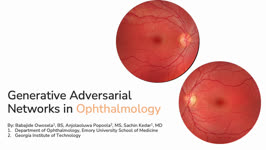 |
Generative Adversarial Networks in Ophthalmology | Babajide Olubusayo Owosela; Anjolaoluwa Popoola; Sachin Kedar | In this video we will describe Generative Adversarial Networks (GAN) models and its applications and limitations in Ophthalmology. GAN, a technique within machine learning, enables computers to utilize real data to generate valuable synthetic data, artificially produced information that mimics the s... | Artificial Intelligence; Generative Adversarial Networks; Machine Learning; Synthetic Data |
| 214 |
 |
NANOS Illustrated Curriculum Section B Introduction | Jason Peragallo, MD | Introduction video to the resources available in Section B of the NANOS Illustrated Curriculum. | Afferent visual pathway; Efferent visual pathway, Pupillary visual pathway; Examination |
| 215 |
 |
Genetic Causes of Isolated Optic Neuropathy | Kathleen Ho; Devin Mackay | Overview of isolated genetic optic neuropathies and their neuro-ophthalmic manifestations with an illustrative case example and discussion of clinical presentation, relevant biochemistry, and testing. | Genetics; Hereditary; MFN2; NDUFV1; OPA1; OPA3; Optic Atrophy; Optic Neuropathy; POLG; SPG7; WFS1 |
| 216 |
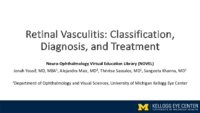 |
Retinal Vasculitis: Classification, Diagnosis, and Treatment | Jonah Edward Yousif; Alejandra M. Maiz; Thérèse Maria Sassalos; Sangeeta Khanna | This manuscript discusses retinal vasculitis and its classification, diagnosis, and treatment. We first discuss the definition and symptoms of retinal vasculitis followed by its classification as a small-vessel vasculitis compared to large and medium vessel vasculitides. Following this, we describe ... | Fluorescein Angiography; Retina; Retinal Vasculitis; Uveitis; Vasculitis |
| 217 |
 |
Macular Edema | Stephanie Chau Nguyen; James Brian Davis; Amanda Dean Henderson | Macular edema can result from pathologic extravasation of fluid through blood vessels in the macular region. This can be a feature of heritable diseases like dominantly inherited cystoid macular edema or acquired causes such as diabetic retinopathy, hypertensive retinopathy, retinal vein occlusions,... | Anti-VEGF; Diabetes; DME; Macular Edema; OCT |
| 218 |
 |
Anatomic and Physiologic Basis for Gaze Stability | Ariel Winnick and Meagan Seay, DO | Diagram describing the anatomic and physiologic basis of gaze stability. | Gaze Stability |
| 219 |
 |
Aberrant Regeneration of Third Nerve | Gregory P. Van Stavern, MD | 48 year old woman S/P rupture and repair of right sided posterior communicating artery aneurysm Video shows residual partial right third nerve palsy, with aberrant regeneration, causing a pseudo Von Graefe's sign (elevation of the right upper eyelid with attempted infraduction of the right eye) Se... | Aberrant Regeneration of Third Nerve; Third Nerve Palsy |
| 220 |
 |
Aberrant Regeneration Third Nerve | Gregory P. Van Stavern, MD | 48 year old woman S/P rupture and repair of right sided posterior communicating artery aneurysm Video shows residual partial right third nerve palsy, with aberrant regeneration, causing a pseudo Von Graefe's sign (elevation of the right upper eyelid with attempted infraduction of the right eye) | Aberrant Regeneration Third Nerve; Third Nerve Palsy |
| 221 |
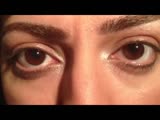 |
Downbeat Nystagmus Anti-GAD Cerebellar Syndrome | Raed Behbehani, MD | A patient with Anti-GAD positive Cerebellar syndrome with ataxia and opsoclonus due to downbeat nystagmus , treated with Baclofen with some improvement. | Downbeat Nystagmus |
| 222 |
 |
See-Saw Nystagmus | Raed Behbehani, MD | This nystagmus localizes to lesions supra/parasellar region (Large sellar and hypothalamic lesion) and is characterized by a see saw movement of elevation/intorsion of one eye and depression/extorsion of the other eye in a pendular fashion. This patient had a large pituitary macro-adenoma with supra... | See-Saw Nystagmus |
| 223 |
 |
Sensory Nystagmus | Tony Brune, DO; Jonathan D. Trobe, MD; Raed Behbehani, MD | A video describing sensory nystagmus. | Nystagmus; Sensory Nystagmus |
| 224 |
 |
Acute Retinal Necrosis (ARN) | Gregory P. Van Stavern, MD | Acute Retinal Necrosis causes inflammation and subsequent retinal detachment. This powerpoint provides images depicting ARN. | Acute Retinal Necrosis (ARN) |
| 225 |
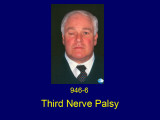 |
Third Nerve Palsy | Shirley H. Wray, MD, PhD, FRCP | The patient is a 50 year old man with Type II Diabetes who presented to an outside hospital in September 1996 with ptosis and an inability to open the right eye. Five months prior to admission (PTA), he had flu-like symptoms with mild fever, sinus congestion and diffuse myalgia in the chest, abdomen... | Ptosis; Unilateral Third Nerve Palsy; Oculomotor Nerve; Meningovascular Syphilis; Heubner's Arteritis; Unilateral Oculomotor Third Nerve Palsy; Third Nerve Microinfarct; Fascicular Third Nerve Palsy |
